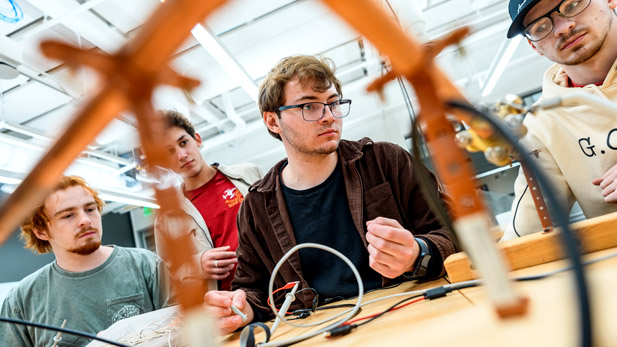Students Develop Entrepreneurship, Industry Solutions During Inaugural Engineerathon Weekend

At the first-ever Engineerathon event, organized by the RISE club, teams of students fueled their entrepreneurial spirit by pitching their own projects and developing solutions to real client problems.
Cole Chmielewski and his teammates discovered during the inaugural Engineerathon weekend that innovation and inspiration can come from the most unusual sources, including dodgeballs on the shelf at Meijer.
That moment of "accidental innovation," as the senior mechanical engineering major put it, was exactly the reason that Chmielewski wanted to participate in the Engineerathon event. "I wanted to experience that spark of innovation," he grinned.
Engineerathon, organized by the Rose Innovative Student Entrepreneurs (RISE) club, paired student teams with professional mentors to define realistic project scopes and gain guidance, advice, and industry insights. Students were also invited to several industry and development talks covering topics from presentation tips to artificial intelligence. Guest speakers included Steve Frank, Matthew Seitz, and 1993 computer engineering alumnus Raman Ohri.
"As fellow entrepreneurs, our goal is to create a strong community of innovation and entrepreneurship. RISE and our leadership team are committed to building one of the top student entrepreneurship and innovation ecosystems in the country," said Deven Wells, president of RISE and a sophomore engineering design major. "Hosting an event where Rose-Hulman engineers could apply their skills in a creative, real-world setting brought that mission to life, and it was incredibly motivating to witness."
Watch the Engineerathon Video
The weekend culminated in two separate competitions: a Startup Pitch Competition and the Engineerathon Demo Competition. In the Startup Pitch Competition, entrepreneurial students who were already working on early-stage startups were invited to deliver a five-minute pitch to a panel of judges. Top teams were offered an opportunity to pitch during the Sawmill Society weekend before the Rose Angel Network of investors.
Andrew Nichols, Elijah Johnson, and Evan O'Brian earned first place in the Startup Pitch Competition, while John Webster and Wells took second place. Matthew Hamilton, Matthew Everett, and Nakul Mital took third.
The Engineerathon Demo Competition paired eight teams of entrepreneurial students with companies seeking to solve a real problem. Over the course of two days, the teams met with their client, researched existing market options, and designed and produced a prototype solution. Teams gave a six-minute presentation about their process and progress before fielding questions from the judges and the audience. The stakes were high: a Bambu Lab 3D printer and a pile of LEGO sets, the grand prize, stood proudly in the corner.
Annie Bullock-Yoder, a 2010 biomedical engineering graduate currently working at NSWC Crane, served as one of the judges for the Engineerathon Demo. She said, "I really liked seeing so many companies involved. They gave students problems, and the students came up with real solutions in about 36 hours, which is pretty incredible."
Chmielewski's team earned the coveted trophy for their work with Guardian Bikes, one of the largest bike manufacturers in the United States. Guardian needed to design a process to automate the application of decals to their bike frame to reduce a manufacturing bottleneck, and prompted by Chmielewksi's off-the-wall dodgeball inspiration, the team developed a Placement & Alignment Device-based idea, which Guardian intends to implement.
The team applied what they had learned throughout the weekend, including during the artificial intelligence talk. "We challenged ChatGPT to create a reference library," said Chmielewski. "It didn't make the decision for us, but it helped us make sure we were confident in our recommendation to the client.
Mitchell Gresham, a first-year electrical engineering student on the Guardian design team, said, "I just think it's really cool to solve an interesting problem and know we changed something that will genuinely help the business."
Students on the Guardian design team also included Mackenzie Racop, Kaden Welch, and Isaac Johanningsmeier.
The second place prize, which included Arduino kits and whiteboards, went to Colin Young, Hayden Dase, Django Wardlow, Prithvi Vijaykrishnan, and Jacob Cockerill, who designed a Pivot Lift Assist for Steel Dynamics, Inc. They were one of three teams presenting innovative solutions to reduce worker strain and danger when loading heavy materials above the workers' heads.
Four teams worked with Lantern to develop a mechanism for mapping pipelines in hospitals. Existing methods were inefficient, requiring the pipelines to be decommissioned for long periods of time. Solutions proposed by the student teams help the hospital understand the lines' connections, reducing the time and costs involved in the process.
Teams each found a unique approach to the problem, including autonomous rovers that mapped the pipes from within ceiling tiles and devices held by a human user to detect the pipes through the ceiling. Jonathan Reid, Will Hartman, Eli Youngblood, Noah Schretzenmayer, and Ben Eldridge earned third place, which included a tool kit and energy drinks, for their solution.
The project was an opportunity for the students to learn outside their majors. Eldridge, a sophomore chemical engineering major said, "The most interesting part of engineering is considering different perspectives. This gave me insight into how my interdisciplinary friends think."
Skills honed during Engineerathon will help students thrive in entrepreneurship and beyond. Racop, a first-year biomedical engineering major, said the event expanded her interest in manufacturing and working with an entrepreneurship coach on presentation skills will help her in other aspects of life, including her internship at Rose-Hulman Ventures.
"It helps a lot to be able to communicate well," she said. "It also taught me how to listen to the client and really hear what works and what doesn’t."
Bullock-Yoder was impressed by everyone involved in the Engineerathon event, including the student organizers and the student innovators.
"The team that put it together did a great job, both sourcing problems and engaging the students, judges, and mentors," she said.
She hopes that the innovative student teams "have a feeling of pride in their entrepreneurship and problem-solving skills. I hope they leave with a sense of accomplishment."